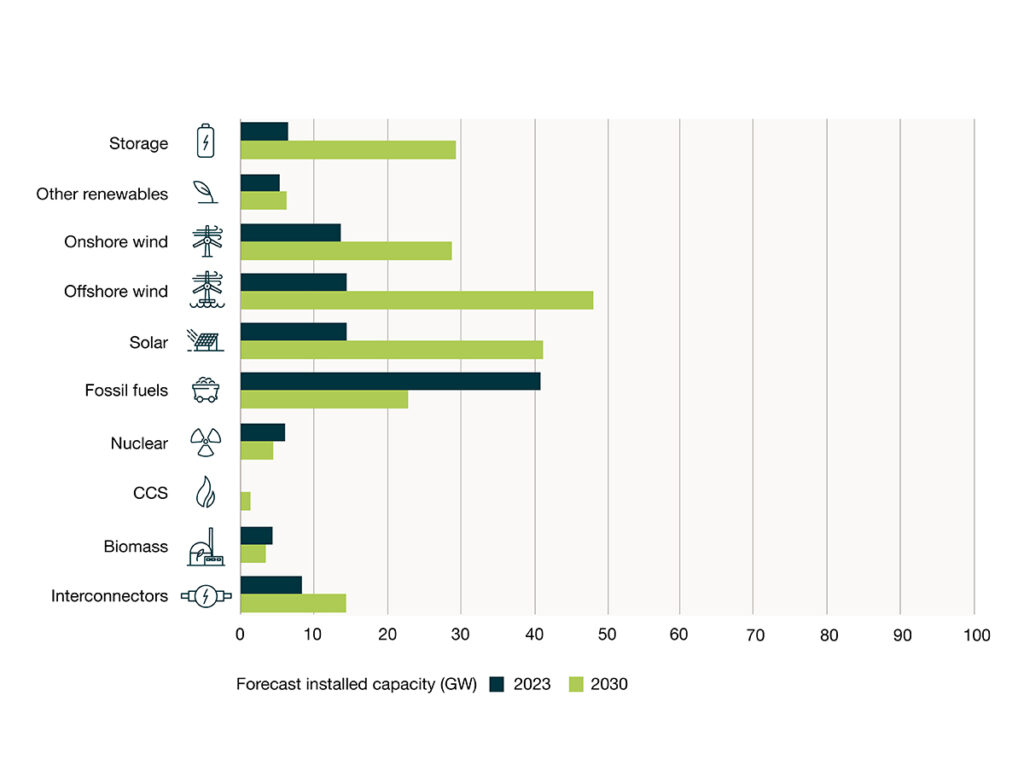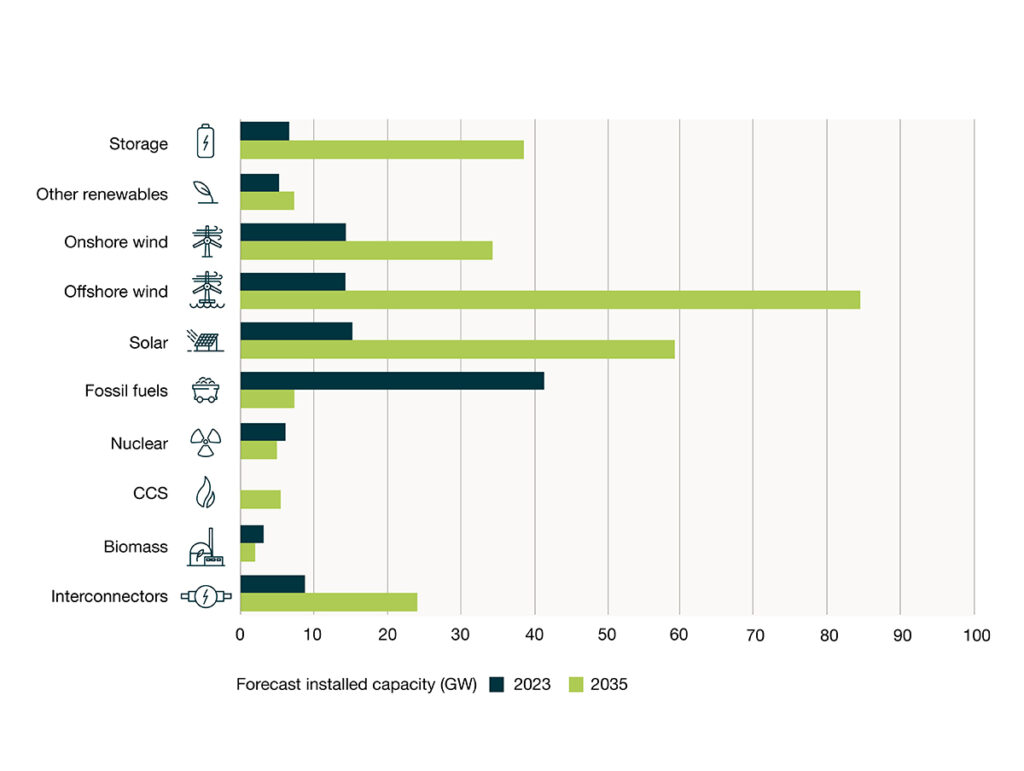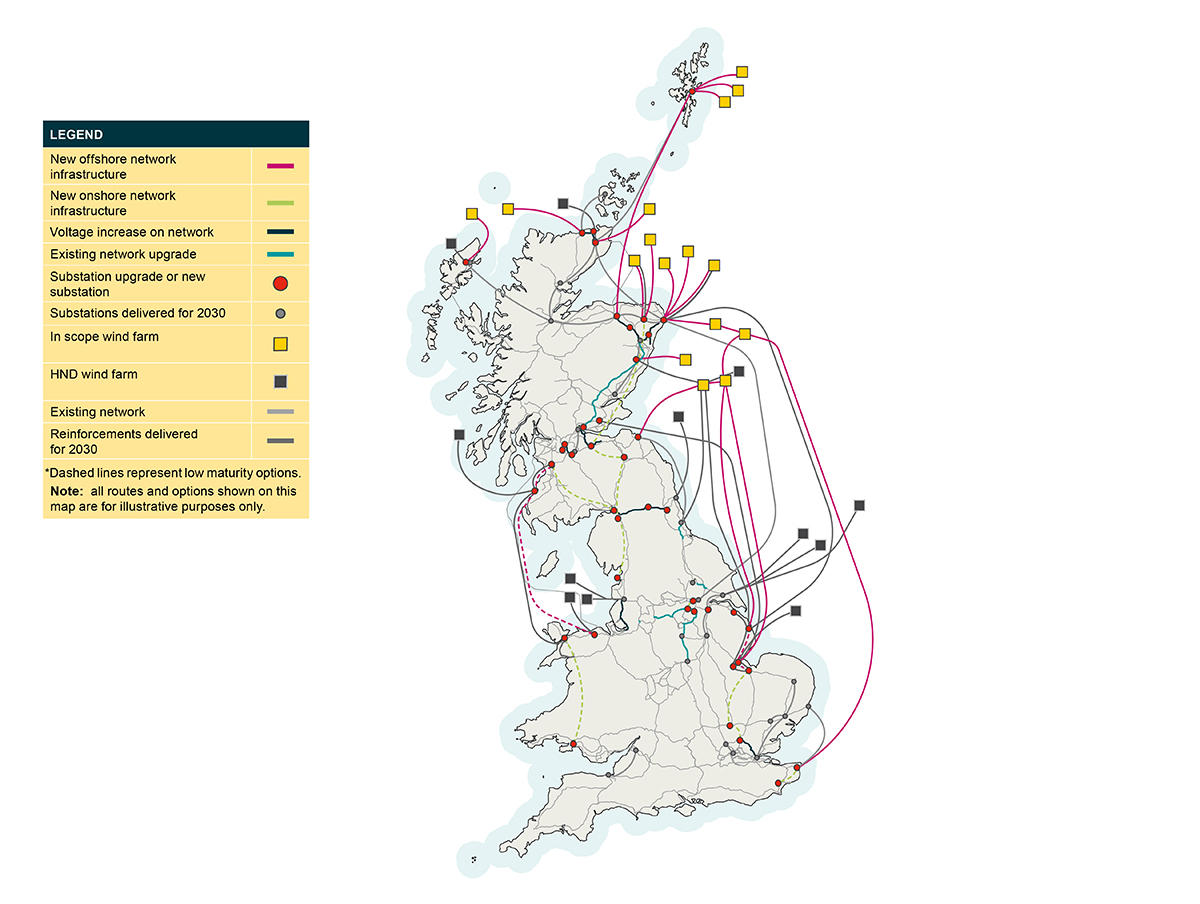The post Reimagining legacy mine closures appeared first on Without Limits.
]]>Drawing on insights from a recent AECOM mine closure executive forum, Sneha Chanchani, our global energy and sustainability advisor, explores how mining companies can navigate this evolving landscape. She explores the value of shifting from a project approach to a program mindset, reframing mine closure as more than just an endpoint. Instead, it becomes a generational opportunity to create a positive legacy by regenerating land, building trust, and creating lasting value for both communities and mining companies.
Mine closure is hard, and getting harder
Mine closure is an inherently complex undertaking. Our proprietary analysis of more than 10 global mine sites shows closure timelines can span decades — often 30 years or more. These long timeframes are shaped less by mine size and more by environmental, social and regulatory intricacies. Even then, the goal of a “walkaway”, free from ongoing obligations, is often elusive. Only a few sites globally have received closure certificates acknowledging the site has been rehabilitated.
As operators take on this long-term responsibility, they are focused on site safety and sustainability, meeting community and regulatory expectations, and managing liabilities. Throughout this multi-generational process, technologies, regulations, best practices and stakeholder expectations will keep progressing, reshaping what responsible and effective closure looks like.
Navigating these challenges has never been easy, but it is becoming harder as expectations rise. Updated frameworks such as the International Council on Mining and Metals’ Integrated Mine Closure: Good Practice Guide (second edition) emphasize social, environmental and economic outcomes. Investors are increasingly entering the conversation, with the Global Investor Commission Mining 2030 calling for mines to leave a positive legacy. The Church of England Pensions Board is pushing for new tailings management standards, and using its financial influence to promote industry-wide compliance.
This pace of change is not likely to slow, so mine operators need an approach with the flexibility to manage closure through long durations and changing expectations. For newer sites, there’s an opportunity to embed closure planning from the outset to lay the foundation for more efficient, sustainable outcomes down the line.
A new approach: From projects to programs
Traditional major project management approaches can be effective for clearly defined infrastructure builds. But they have limits when it comes to the long timelines and shifting variables of mine closures. Project plans made at the start of the closure often struggle to accommodate changes over 30 years.
One effective solution is shifting from a project-based approach to a program management model. This means managing initiatives as part of a broader strategy — working holistically to deliver long-term outcomes through integrated planning, consistent delivery models and a focus on continuous improvement. A programmatic approach enables greater flexibility, measurable progress and cross-functional governance. It is dynamic, phased and responsive — equipping mining companies to navigate shifting risks and expectations, capitalize on emerging opportunities, and respond to evolving community needs, ultimately increasing the certainty of a successful closure.
A rigorous plan is still critical, of course. A successful program still begins with robust stakeholder engagement, leading to a shared vision of closure criteria, post-closure use and ongoing stewardship. Whether the goal is ecological restoration or redevelopment, this plan establishes a strong foundation and clear direction for everyone to work toward.
But the plan also embeds contingencies and continuous improvement into its DNA. Program-based closure incorporates ongoing reviews, even post-closure, to assess best practices in light of shifts in technology, climate, regulations, workforce and stakeholder expectations. It integrates lessons learned from other projects, ensuring the plan remains current, informed and resilient.
Program management promotes a fundamental mindset shift for those delivering it. Success depends on equipping managers with the tools and training to operate within a “plan, do, assess, learn” cycle — one that prioritizes learning over fixed delivery and encourages experimentation and innovation.
All of this supports early identification of issues and continually spots opportunities to improve. Take stakeholder engagement: ongoing dialogue helps teams stay aligned with evolving expectations throughout the closure process. Or technology: routine assessments allow mines to benefit from advances in areas like artificial intelligence, sensing and automation — tools that could dramatically reduce cost or improve outcomes.
This kind of adaptability helps prevent issues before they escalate. It enables mine closures to evolve with changing conditions, ultimately reducing closure durations, liabilities and costs.
Long-term value for mining companies and communities
A long-term program management mindset is a powerful tool to improve the closure process. But it also opens the door to lasting, value-generating outcomes through ongoing stewardship.
For instance, nature-based solutions like reforestation and wetland restoration can produce ‘habitat credits’ and ‘carbon credits’, which can be sold to offset environmental impacts elsewhere. Kennecott Utah Copper has restored 3,670 acres of saltpans and industrial land into shorebird habitat along Utah’s Great Salt Lake. A Utah Department of Natural Resources study suggests this project and others like it could generate tens to hundreds of thousands of dollars per acre in wetland credits to help offset ongoing monitoring costs.
Repurposing sites for renewable energy offers another opportunity. Chevron’s Questa Mine in New Mexico installed a one-megawatt solar facility on its tailings area, selling electricity to the local cooperative under a long-term contract.
These strategies enhance environmental outcomes and unlock new revenue streams. They also strengthen the social license to operate — closures that create community value can build trust with key stakeholders and reduce the risk of post-closure concerns arising.
Leaving a lasting legacy
Mine closure is more than a technical challenge or a regulatory requirement. It is a strategic opportunity to demonstrate value, build trust and leave a positive legacy.
By adopting a program management approach — flexible, responsive, and long-sighted — mine operators can deliver lasting outcomes that meet diverse needs, and shape a future where closure is not the end of the story, but a new beginning.
To learn more about legacy mine closures, reach out to our mining leads or contact your AECOM account manager directly.
The post Reimagining legacy mine closures appeared first on Without Limits.
]]>The post Carbon capture, utilisation and storage in Australia: If not now, when? appeared first on Without Limits.
]]>While global peers have accelerated investment in carbon capture, utilisation and storage (CCUS), Australia is falling behind despite our comparative advantage and opportunity to lead.
As global demand shifts toward low-carbon value chains, Australia has a rare opportunity to leverage its traditional resource exports, not only to lay the foundation for a competitive CCUS industry, but also to enhance our value proposition across both existing commodities and emerging low-carbon supply chains. Is this another example of the lucky country not taking advantage of its full opportunity?
As the world grapples with the urgent need to reduce greenhouse gas emissions, Australia stands at a pivotal moment in its journey towards a meaningful contribution to a Paris–aligned global net-zero outcome. AECOM’s recent study commissioned by Infrastructure SA (ISA) highlights the critical role CCUS can play in achieving net-zero emissions and how South Australia has the key ingredients to make it happen.
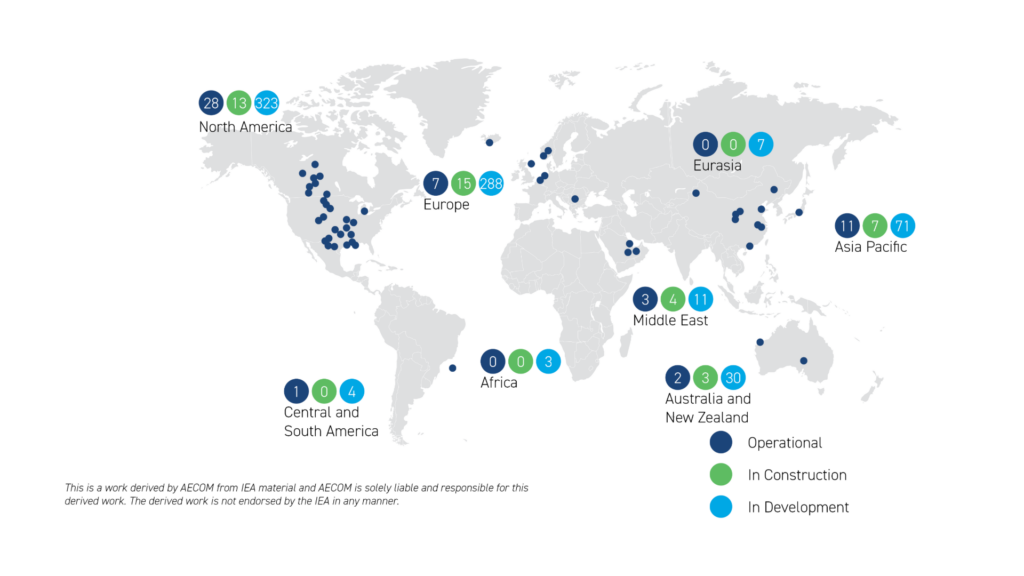
With a more aggressive nationally determined contributions (NDCs) due ahead of COP30 in Brazil, and in the race to host COP 31, Australia is under growing pressure to step up its decarbonisation commitments beyond the current 43 percent by 2030.
The recent 2023 Net Zero Australia study found there is almost no reality where we can reach net zero emissions by 2050 as a nation without developing our CCUS industry.
This is because it is one of the only technologies able to decarbonise certain hard-to-abate sectors, such as cement manufacturing, iron and steel production, chemicals, fertilisers and explosives, including their natural gas feedstock inputs.
Speaking of gas, the rhetoric has changed, and I think it’s safe (relatively, but I’ll hold my breath) to say it’s embedded as a key requirement in an orderly transition. These are also some of the most important sectors for our economy.
Is CCUS a perfect solution?
Let’s be clear: CCUS hasn’t always had the best reputation, and in many cases, that criticism hasn’t been without merit. Projects like Gorgon CCS in Western Australia, which failed to meet its injection targets and had major delays, cast doubt on Australia’s ability to build and commercially operate these facilities despite it capturing and storing over 10 million tonnes of CO2 to date. Not an insignificant amount when you compare this to 2023/2024 year to September national reported emissions of 434.9Mt CO2-e.
The reality is CCUS is not a silver bullet solution to decarbonisation. It should be considered as one of many complex pieces of the puzzle we need to effectively decarbonise, particularly for hard-to-abate sectors.
In South Australia, Santos has demonstrated its 1.7 Mtpa CCS ‘pilot’ plant ramping up to nameplate capacity with a Memorandum of Understanding signed, with various international off-takers for a 20 Mtpa plant expansion.
How does CCUS work?
CCUS is the process of capturing carbon (in the form of CO₂) and either permanently storing it using geological formations (commonly depleted oil/gas fields or saline aquifers) or transforming it so it can be used in various applications (cue the U in CCUS).
To simplify the flow, the premise of the technology is to intercept and capture CO₂ that would otherwise be expelled into the atmosphere, compress it into a supercritical fluid (flows like a gas but dense like a liquid), transport it, and redirect it to ‘permanent’ storage or for productive re-use.
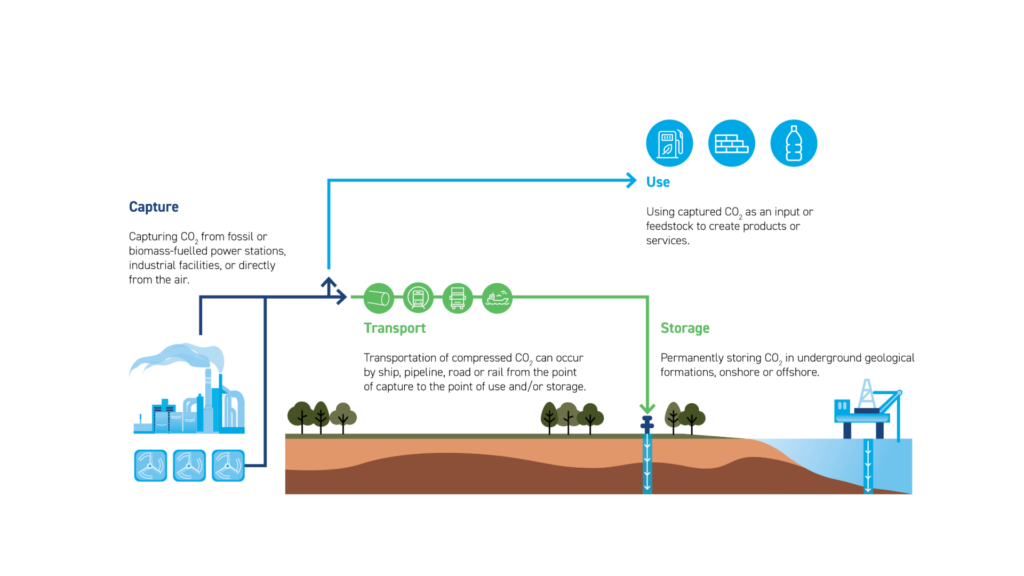
CCUS can also be a form of negative emission technology (NET) where carbon dioxide is directly captured from the atmosphere, hence the technology term for this application ‘direct air capture’ or DAC as it’s commonly referred. While economically challenged today, major offtakes and investment from major tech companies such as Microsoft and Amazon will no doubt steepen the learning rate and lower the technology cost over time. Let’s not forget nature based solutions (NbS) either, with growing interest in applications such as mineral carbonation of certain tailings as an example.
The ‘U’se case is broad, such as directly into food, beverage and agriculture industries or indirectly, for applications such as e-fuel production.
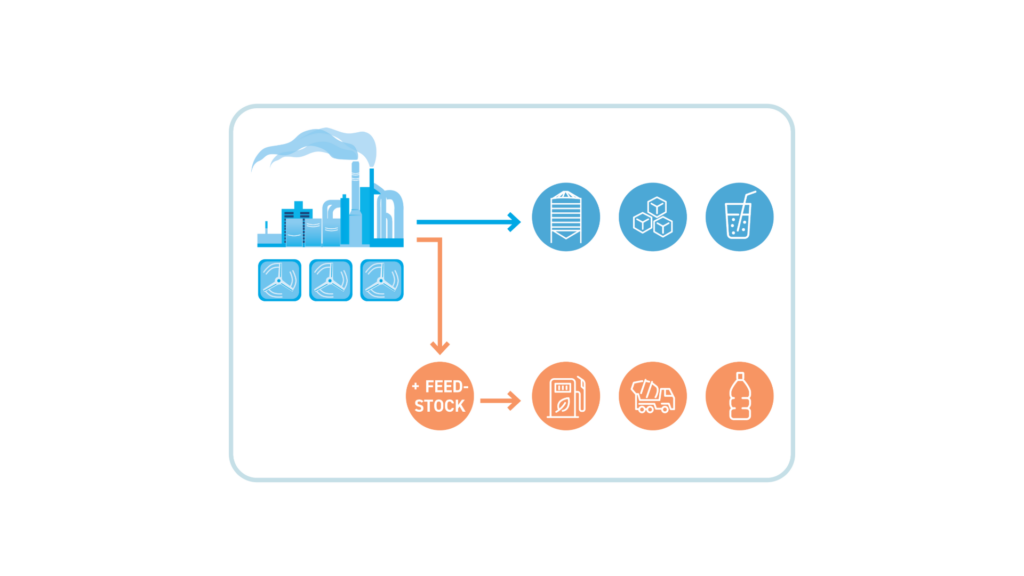
How would CCUS work in South Australia?
We studied how a CCUS infrastructure and supply chain could work in South Australia. We found a key competitive advantage for CCUS in South Australia both in its geology and experience workforce.
Depleted oil and gas reserves typically sit at a much greater depth and thus carry an advantage for how the molecule behaves in its supercritical phase. They also have proven geological seals that have safely contained hydrocarbons for millions of years, making them highly reliable for long-term CO₂ storage. When we look to the Cooper basin, there are also significant pre-existing gas pipelines and associated infrastructure corridors in place, which may be leveraged for its transportation.
So, what does a successful CCUS supply chain look like?
What does this look like in practice for South Australia as a global player?
- Natural gas extracted from the Cooper Basin has its process emissions captured by the Moomba CCS plant.
- Let’s assume electricity supply for the Moomba operation is also decarbonised, with abundant and coincident renewable energy.
- This gas is then sold to global trade partners, like Japan, which is the largest global importer of LNG, that have ambitious net-zero targets including aggressively transitioning coal fired power generation to gas coupled with CCS.
- The CO2 from gas-fired power generation is captured and shipped back to Moomba where it is safely stored in its place of origin (being a depleted oil and gas reservoir that has hosted the original hydrocarbon molecules safely for millions of years).
In practice, this is an innovative example of a true circular economy.
The physical infrastructure proposed by AECOM as required for a carbon capture supply chain would centre around a ‘common user hub’, a model gaining much favour across state and federal government for its many benefits.
CCUS hubs worldwide operate under various ownership and procurement models, shaped by policy, funding structures and efficient risk allocation. The main models include:
- Public-private partnerships (PPP): Where governments and industry share costs and risks.
- Industry-led consortia: With multiple members collaborating on shared infrastructure.
- Government-owned, industry-operated: Where there is public control with private expertise.
- Private sector-led with government incentives: Which is driven by policy incentives or tax credits.
- Build-own-operate (BOO): Where a single entity manages the full value chain.
The hub model aggregates the individual carbon emitters to a single location where costs for conditioning and compressing the gas suitable for transport can be shared. The hub model reduces risk due to operational standardisation, and incentivises hard-to-abate operators as it helps lower costs (which are shared between emitters) and allows for opportunity to scale as additional emitters come online.
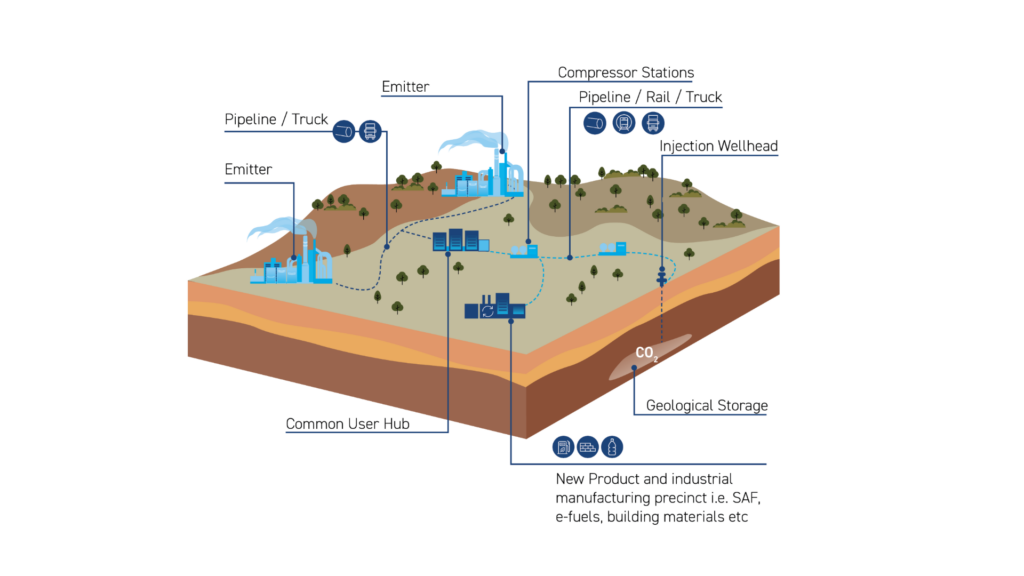
The hubs could be set up near already functioning industrial clusters that collectively generate significant carbon emissions. In South Australia, we identified this within the Upper Spencer Gulf, a key regional area highlighted in the Net Zero Economy Authority priorities. Not only does it have a significant integrated steel industry, but it also has the right infrastructure to support global and national import infrastructure for a CCUS supply chain. The industrial hub model also supports job attraction and contributes to the growth of the local economy.
Could this model be applied to the rest of Australia?
While we recommend that the first phase of a functioning CCUS supply chain begins with the Upper Spencer Gulf industrial common user hub in South Australia, we identified two other clusters in New South Wales and Queensland that have solid fundamental conditions to use the hub model.
These are regional communities impacted by the energy transition where we’ve seen a steady decline in their original industrial industries – perhaps CCUS could also play a role in regenerating local employment?
Read Infrastructure SA’s CCUS infrastructure and national supply chain study, prepared by AECOM.
Figures used throughout this article are credited to Infrastructure SA’s “Carbon Capture, Utilisation and Storage” infrastructure and national supply chain study.
The post Carbon capture, utilisation and storage in Australia: If not now, when? appeared first on Without Limits.
]]>The post Aussie rules for offshore wind: Five must-know insights for developers appeared first on Without Limits.
]]>In reality, Australia presents a potentially frustrating mix of challenges: a vast grid that isn’t always ready for large-scale offshore wind integration, complex and misaligned federal and state approval pathways, high regulatory expectations but limited baseline data, and unpredictable community engagement dynamics. Developers who rely on what has worked elsewhere risk major delays and cost overruns.
As the approvals consultant for the nation’s most advanced offshore wind farm, Star of the South, we have been at the forefront of the local offshore wind industry since 2019. But our experience goes well beyond offshore. For more than a decade, we’ve delivered planning, design and engineering services across transmission and distribution networks for Australia’s major utility operators. From grid connection negotiations and network modelling to corridor planning and substation design, our integrated capability — and deep understanding of local standards and key stakeholders — means we can look at the bigger picture across the full development lifecycle.
This is further strengthened by team members with offshore wind experience from around the world, giving us a clear view of what ‘normal’ looks like for international developers, and where the Australian market differs. Based on this combined experience, here are five critical insights every offshore wind developer should know before entering the Australian market.
De-risking offshore wind projects in Australia
1. Disjointed connection frameworks increase integration risk
Australia’s grid connection process is more complex than many international developers expect. Australia’s National Electricity Rules and network planning requirements present real challenges; no clear framework for shared infrastructure, limited coordination across offshore projects and no dedicated provision for transmission corridors.
Through our involvement in more than 25 projects over the past five years, we’ve seen how early awareness of evolving grid regulations is critical. In one case, we resolved a mid-project clash between reactive power requirements and inverter capabilities through early technical engagement and negotiation.
Offshore components like turbines and inverters can also face approval hurdles if they’re not already recognised under Australian standards. We’ve supported clients through this process, helping to navigate model approval and working with industry groups to ease the path for new technology.
2. Australia’s grid network is fundamentally different
Australia’s grid is isolated, low-density, long, stringy and unmeshed. It’s difficult and time-consuming to connect. With a small population and state-based grids (for example, Western Australia’s standalone system), load sizes are smaller. In Victoria, the single biggest allowable loss of a generation connection is 600 megawatts. This often necessitates stability systems and batteries to secure a connection agreement and protect grid integrity.
3. The tyranny of distance is real
Australia’s remoteness poses major logistical challenges. Long shipping distances, limited local manufacturing and exposure to global supply chain disruptions all increase costs and lead times. Offshore components often require modifications, such as complete rewiring, to meet local standards. These are crucial considerations during development and contracting.
4. Offshore wind regulation is complex and fragmented
Australia may look familiar to international developers. Its transition policies often echo those of the UK and Europe, and regulators are generally open to adopting global best practice where local guidelines are still evolving.
But beneath the surface, things get complicated. Each state has its own environmental and planning approval pathways, often overlapping with Commonwealth requirements. For example, projects beyond three nautical miles fall under federal jurisdiction alone, but those closer to shore must meet both state and federal approvals. The same applies to species protection, with threatened or migratory species potentially governed at one or both levels.
Compounding the challenge is a lack of detailed ecological baseline data, particularly compared to Europe. This makes local expertise essential. We work with trusted partners, like JASCO Applied Sciences for underwater noise, BMT for marine ecology and Nature Advisory for bird impact assessments, as we’ve done for Ørsted’s Gippsland 1 Offshore Wind Farm.
New entrants should be prepared for a regulatory environment that’s still maturing. Interpreting requirements, not just following them, is often necessary, and online guidance quickly becomes outdated. Strong local relationships with regulators can make all the difference. Our long-standing engagement with key agencies ensures we stay ahead of change and help our clients do the same.
5. Poor community engagement threatens social license to operate
In Australia, renewable infrastructure can be polarising, especially offshore wind, which interacts directly with our treasured coastline. With 85 percent of the population living within 50 kilometres (31 miles) of the coast, many communities are deeply connected to recreational activities like surfing, fishing and camping, and wary of anything that might disrupt that way of life.
Projects that fail to engage early and meaningfully with local communities risk being derailed by public opposition. But reactions vary widely. The Gippsland community, for instance, continues to show strong support for offshore wind, thanks to the groundwork laid by Star of the South. Community support for this came from listening to what mattered most; for Gippsland, it was recreational fishing, and taking steps to minimise impacts, such as protecting nearshore fish populations and limiting exclusion zones during construction.
Engagement goes beyond consultation. Communities respond positively when they see real local benefits: job opportunities, supply chain involvement and housing solutions that prevent rent hikes. In the EU or UK, housing construction workers who are flown in to work on an offshore wind project might be a challenge, but here in Australia, amid a rental crisis in low-populated regions, it could become a deal-breaker. Some developers are addressing this by recruiting local workers and facilitating accommodation that can later be converted for other uses, meeting short-term needs and leaving a positive legacy.
A safe pair of hands in offshore wind
Success in Australia depends on local knowledge, relationships and credibility, across both engineering and environmental disciplines. We bring deep local experience, global offshore wind capability and trusted partnerships with local experts and stakeholders.
We help developers interpret complex regulations, navigate approval processes and build meaningful community engagement strategies. With our finger on the pulse of regulatory change, we know how to de-risk offshore wind development in Australia, from concept to construction, by playing by Aussie rules.
The post Aussie rules for offshore wind: Five must-know insights for developers appeared first on Without Limits.
]]>The post With growing pressure on transmission and distribution, collaboration offers relief appeared first on Without Limits.
]]>As a result, power utilities are challenged to think quickly about expanding capacity, advancing local policy goals and building resilience, all while electricity prices are rising faster than inflation and affordability is already a real concern for many Americans. Our U.S. climate advisory lead, Katrina Lewis, sat down with senior leaders from electric utilities across the country to discuss this era of challenging tradeoffs and the critical need for collaboration and strategic partnerships to navigate the evolving grid.
Keeping pace
The convergence of policy, skyrocketing energy demand and resilience investments are driving an unprecedented scale of investment and pace of execution that far outstrips that of years past. According to BloombergNEF, U.S. electric utilities are anticipated to invest over US$3.75 trillion in the grid over the next 25 years, more than any other country or region. As such, the involvement of all key stakeholders is required to thoughtfully plan, manage and execute this feat.

Utilities are anticipated to invest over US$3.75 trillion in the grid over the next 25 years
In response, we’re witnessing early pivotal utility rate cases in U.S. states like Ohio, where the tension between the need for growth and the impact on rate payers is being negotiated in real-time, potentially setting important precedents for other states. In various parts of the country, some stakeholders blame utilities for being too slow to keep pace with demand from new loads. Furthermore, utilities across the country are grappling with how to enhance resilience of the grid to natural disasters while maintaining affordability.
Key themes for electric utilities
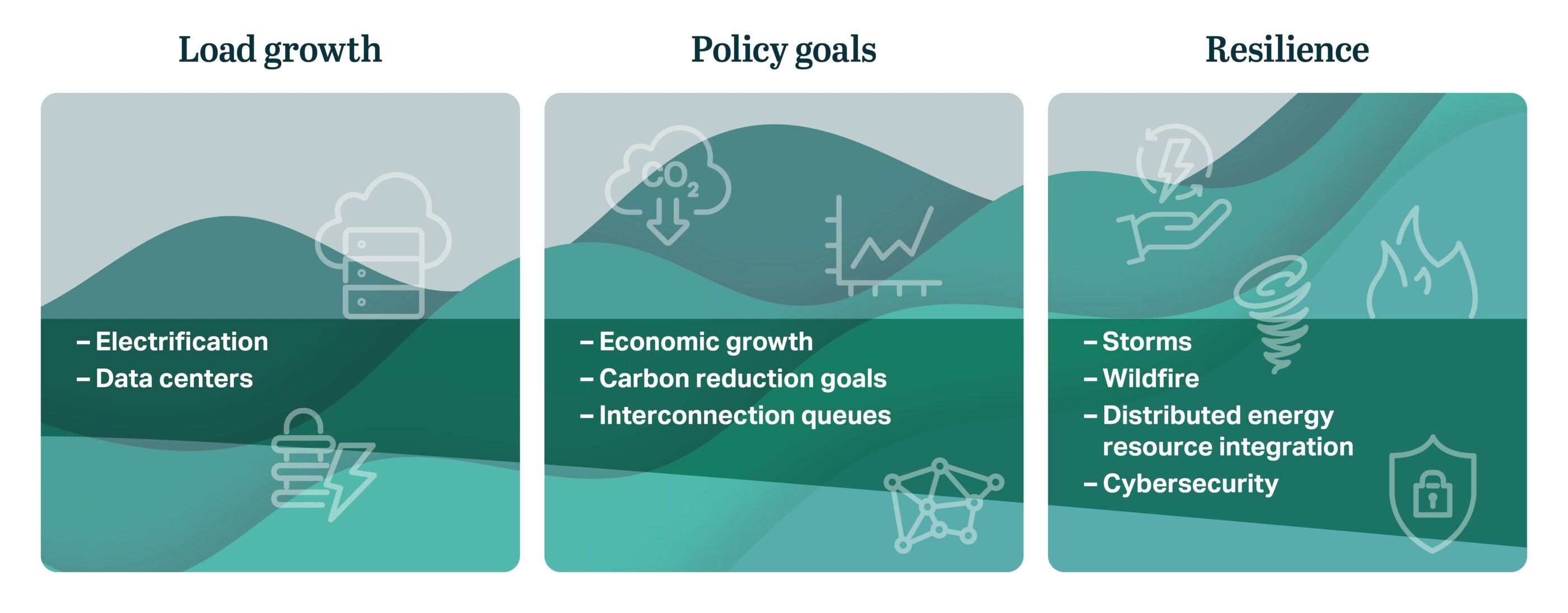
We meet with a lot of our large customers in San Diego regularly and try to get their vision five to ten years out…We’re trying to get in front of it so we know where people [will] be, where the demand is going to be, [then] make investments, so we’re there ahead of time.
Will Speer, San Diego Gas & Electric, United States
Taking back control
Given the pace of change and the volume of demand growth, we offer an essential exploration of new partnership approaches for electric utilities:
1. Embrace evolving partnership models. Driven by the changing environment, utilities are having to manage programs to complete more work, faster, all while driving cost down to preserve affordability. At the same time, there is an increasing gap between available resources and skillsets needed to manage and deliver this work. Strategic partnerships are critical in securing a well-qualified workforce. Beyond resources, when partnerships are developed with suppliers who share common values, and who are willing to agree to be measured on shared objectives, that fundamental alignment and risk sharing helps motivate exceptional performance. This mitigates financial and technical risk and, ultimately, can be instrumental in helping utilities achieve their ambitious goals.
Case study:
An innovative partnership model: SDG&E Alliance
In 2022, AECOM began supporting San Diego Gas & Electric Company’s (SDG&E) Strategic Undergrounding Program, a critically important program that aims to reduce wildfire risk and improve electric safety and reliability during extreme weather conditions by burying power lines. The program uses an innovative program management structure in which every member of the team is measured by the success of the program overall. This One Team approach – which spans internal and contractor resources and has grown into a culture and way of working – has accelerated the pace of the undergrounding while reducing the cost per mile of work, helping to protect the people of San Diego.
2. Expand the scope and scale of proactive collaboration. Utilities have come a long way in evolving their planning frameworks to enable the timely interconnection of load and generation. However, with increasing electrification, there’s greater need for granular forecasting and a deeper understanding of adoption trends across customer classes and service territories to identify necessary upgrades. Utilities will need to embrace an industry-wide collaborative approach to better forecast and understand the impacts of building and vehicle electrification on the grid, municipal and state-level climate policies, and how all of this impacts our communities. In California, we’re seeing utilities changing the way they do long-term grid planning by collaborating with customers to develop a view on anticipated, rather than confirmed, future loads.
Collaboration and partnerships are important for us internally and externally. [we are] trying to really understand what customers and clients want.
Amber Young, Pepco Holdings, Inc., United States
3. Focus on program management excellence. Electric utilities aim to improve operational efficiencies and customer satisfaction and need to be thinking through risks and contingency planning to keep projects and programs on track despite the curveballs and challenges they’ll face. For some, this type of programmatic thinking and strategic risk management is already institutionalized within their capital programs teams. For others, program management consulting partners can help improve program/project delivery efficiency and outcomes by focusing on rigorous management of scope, schedule, cost, supply chain and risk. Taking the time to establish a thoughtful program/project management delivery partnership model can help utilities achieve impactful outcomes.
In order to keep pace and meet our goals, focusing on strong project and program management is key: what we do every day is risk management and contingency planning.
Patricia Lombardi, New York Power Authority, United States
A historic level of investment is being made to transform the energy grid. From new business, planning and forecasting to innovative program management approaches, electric utilities across the country are embracing proactive collaboration. The rapid energy transition requires industry-wide partnerships for long-term success. By breaking out of well-defined patterns, electric utilities can overcome the building pressures and effectively navigate today’s utility and policy landscape.
The post With growing pressure on transmission and distribution, collaboration offers relief appeared first on Without Limits.
]]>The post Decarbonize your city with an integrated approach appeared first on Without Limits.
]]>City-wide decarbonization efforts are often driven by national, state or local government emissions targets and associated grant or incentive opportunities to support these. To meet these targets, authorities and estate managers can often fall into the trap of working in decarbonization silos; for example, tackling issues around heating, electric vehicles (EVs) or public transport independently. The default method is to focus on individual short-term solutions, but addressing these areas separately can result in inefficiencies and challenges down the line.
The big-picture approach
Intelligent integration is a way of holistically viewing decarbonization pathways. The focus remains on emissions reduction, while also identifying efficiencies that might be gained or secondary effects that could be mitigated. A systems thinking approach is crucial in prioritizing demand and determining the best solutions — whether that’s adopting clean fuels for transport or implementing alternative heat sources into buildings. It also integrates energy resilience naturally throughout the demand reduction and local generation/storage processes. This is particularly important when considering the geopolitical factors affecting energy supplies today and the grid instabilities we are increasingly seeing.
With a systems thinking approach — leveraging new infrastructure for multiple uses and with local generation and storage, integrated into the wider networks — cities can significantly improve energy resilience and support essential services during disruptions, emergencies or peak demand periods. This can be achieved through a combination of local solar panels, energy storage, heat storage, smart controls and interconnection. Further, diversifying energy sources strengthens energy transition efforts (such as demand reduction and electrification), making regions more resilient and reducing the need for so much infrastructure upgrade or state-level storage solutions
Overcoming the challenges
Systems thinking has many benefits, but there are still challenges that need to be considered and overcome. The benefit of this approach, though, is that many solutions can be assessed and integrated from the outset. The top three challenges cities face include:
1. Funding. In the long run, well-designed decarbonization policies can lead to reduced costs for everyone (as demonstrated below), yet implementing these policies involves significant upfront investment. In the short term, these costs must be affordable for the end-user and not place individual households in a position where they cannot afford the cost of their energy needs.
A systems thinking approach — looking at the picture as a whole — can collate multiple schemes, increasing the value and therefore the attractiveness of the funding proposition. For example, coordinating the installation of heat networks, EV charging infrastructure, smart grids and cycle lanes can reduce costs and minimize disruption by aligning civil works. Similarly, combining building-level improvements with generation initiatives can unlock different private sector funding streams.
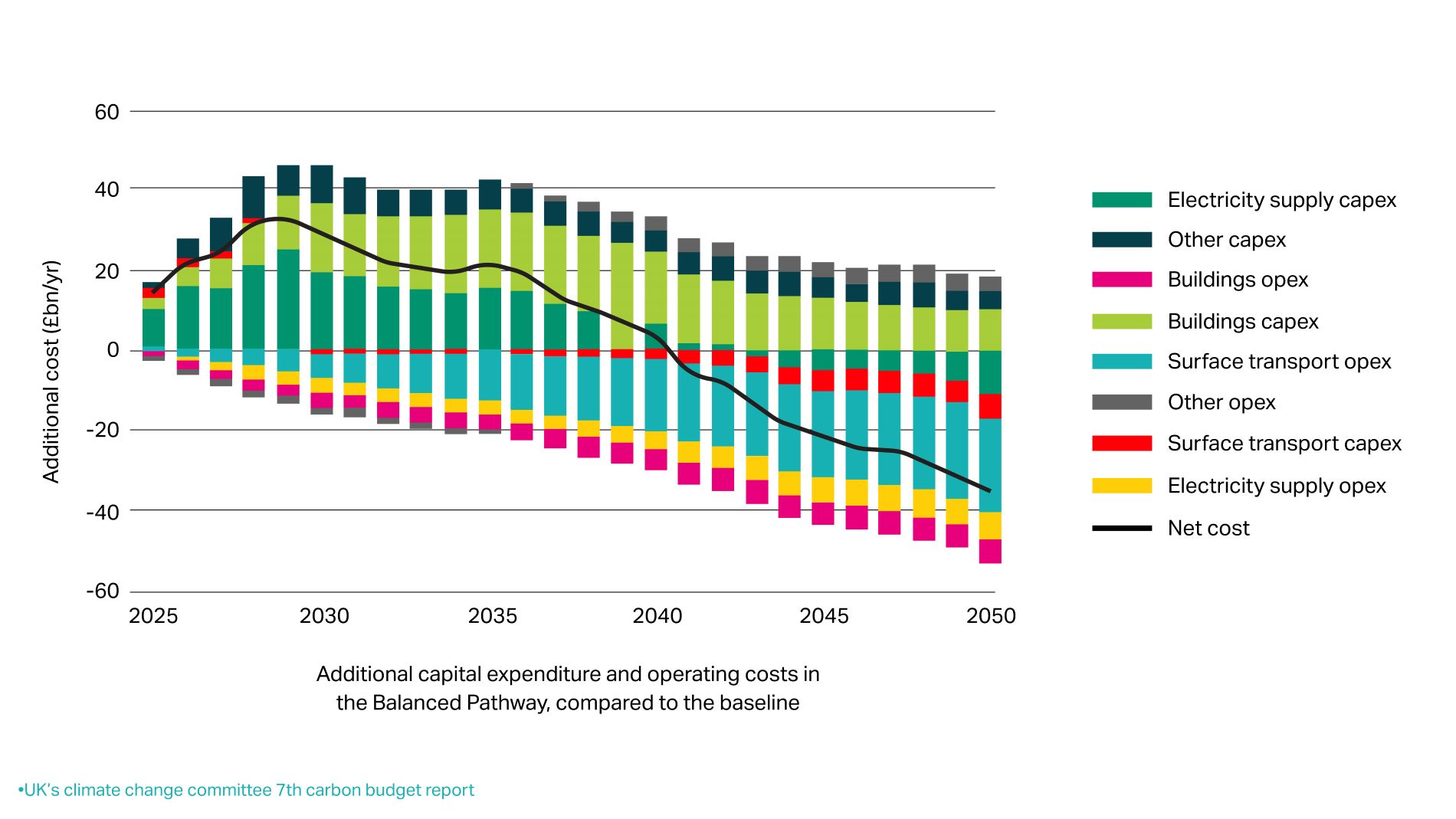
‘Techno-economic modeling’ can also help illuminate investment opportunities by estimating the technical performance and economic viability of a proposed project. By showing how a project can work in practice, potential funders can have greater confidence in the return on investment (ROI) of decarbonization.
Alternative financing models, such as public-private partnerships (P3s), can also help cities fund critical infrastructure upgrades. For example, we designed and implemented the largest wastewater heat recovery district energy system under a P3 at the National Western Center in Denver, Colorado, U.S.. In what would typically be an out-of-reach capital investment and operational challenge for a city to undertake through traditional financing methods, the City of Denver established a dedicated authority to focus on the management and facilitation of third-party financing, delivery and operations. By structuring financing in this or similar ways, cities can implement ambitious decarbonization projects and do so in shorter time frames, maximizing the benefits.
To this end, we supported Miami, Florida, U.S. in developing its Climate Action Plan to achieve carbon neutrality by 2050. This work included a whole-system analysis of the city’s green economy and identification of the key green industries primed for growth. Among these are solar energy initiatives, transportation electrification and increasing micro-mobility options – all of which would help achieve a reduction in greenhouse gas emissions, support the local economy and deliver worthwhile financial returns.
2. People. Driving behavioral change is an essential part of the system. Technologies like EMS (environmental monitoring systems) can incorporate artificial intelligence to provide more accurate demand control for utilities by tailoring energy use around individual lifestyles. However, many people are uncomfortable about losing authority over their energy provisions — a challenge that extends to other carbon-intensive sectors, such as transportation.
A systems thinking approach encourages communities to work with behavioral change experts, outreach specialists and community engagement leaders. By clearly communicating the long-term financial and environmental benefits of championing new habits in a relatable way, cities can win the support of both residents and businesses.
We’ve been working with the Greater Manchester Combined Authority (GMCA) to implement a systems thinking approach to help them meet their heat decarbonization targets. The integrated program seeks to support the delivery of strategic scale heat decarbonization — large-scale efforts that connect multiple urban areas — at the city and city-region level. We developed business cases for portfolio–level programs, focusing on assets under the control or influence of GMCA and the local authorities across Greater Manchester that are built on tangible projects with both technical and commercial solutions. Consumer choice plays a critical role in the success of these solutions, and building public confidence and understanding in heat networks can significantly improve both the commercial viability of the program and the carbon savings achieved as more buildings connect.
3. Avoiding grid constraints. Moving away from fossil fuel generation hubs places greater strain on different parts of the electricity network, including local systems. On a micro scale, heat pumps have been identified as a cleaner solution to home heating and hot water, but they are already putting a heavy load on the grid.
A systems thinking approach helps cities and utilities view the broader picture. By shifting demand onto private wires and ‘microgrids’ — networks of campus– and community-scale energy infrastructure — they can lighten the load on the main grid, reduce costly upgrades and deliver major program savings for communities and local businesses. This approach can also strengthen overall grid resilience and enable smarter, more efficient energy use. Over the past several years we’ve partnered with the City of San Jose in California, U.S., to analyze, develop and design microgrids and resiliency solutions for various sites. We integrated novel technologies into new and existing electrical power grids for efficient microgrid deployment for a convention center, community center, amusement park and the zoo. This resulted in increased operational resilience, demand management reliability, and energy supply decarbonization across the city.
Taking the first steps towards systems thinking
Realizing national and international climate ambitions will demand a shared effort, with towns, cities and states playing a vital role. Barriers such as securing funding, encouraging meaningful behavioral change and managing energy demands are real — but not insurmountable. With a systems thinking approach, these challenges can be addressed through coordinated action built around lasting community buy-in.
City-wide decarbonization is about more than reducing emissions — it’s about people, communities and creating places where clean, reliable energy supports better homes, more connected transport and stronger local economies. Systems thinking can help reduce energy bills, strengthen energy resilience and achieve emissions goals.
Decarbonization at the city-scale isn’t easy — but with the right partner who sees the big picture and applies a systems thinking approach, the benefits for your communities and local economy are well worth the effort.
To learn more, visit: Portfolio decarbonization and climate resilience.
The post Decarbonize your city with an integrated approach appeared first on Without Limits.
]]>The post Power at risk: The cybersecurity threat facing renewables appeared first on Without Limits.
]]>In response to these increasing physical threats, we commissioned an independent survey, in partnership with Cyber Energia. Our global energy advisory lead, Adrian Del Maestro, global offshore wind lead, Dawn MacDonald and Cyber Energia’s business development lead, Darrel Ellis discuss the findings and offer a fresh perspective on cybersecurity in the renewable energy sector.
Our jointly commissioned survey solicited thoughts from business leaders to assess the impact cyberthreats have on investment and operating strategies. The research captured insights from senior financial and operational leaders, asset managers, developers and technology providers, such as Gore Street Capital and Gresham House.
Results illuminate how cybersecurity is viewed as a business risk: shaping investment, governance and resilience strategies across the energy sector and beyond. Moreover, the survey results illustrate how businesses in renewable energy will need to do much more to improve cyber resilience if we are to mitigate the risk of the ‘lights going out’ in an increasingly complex geopolitical landscape.
Key data findings
Cybersecurity investment: Despite growing risks and concerns, investment levels remain low, and corporate response is reactive.
- The majority (95 percent) of asset owners interviewed allocate only 1–2 percent of annual revenue to cybersecurity, integrating it into broader risk management rather than treating it as a standalone priority. Companies would be well advised to address shortfalls in spending, considering the potential impact. Cyberattacks, such as ransomware, can disrupt operations for weeks or even months, potentially resulting in losses of millions.
- One in 10 companies surveyed stated they had already suffered a cyberattack, highlighting the immediate and growing risks facing the industry.
- Respondents note that regulatory compliance is becoming more demanding, requiring stricter supplier risk management with mandates such as:

1 in 10 companies surveyed stated they had already suffered a cyberattack.
- The Network and Information Security (NIS2) Directive in the European Union (EU), an EU directive expanding cybersecurity rules for critical sectors, including energy, with stricter risk management, reporting and penalties.
- The North American Electric Reliability Corporation (NERC) Critical Infrastructure Protection (CIP), a North American cybersecurity framework requiring utilities to protect critical power infrastructure from cyber threats through strict security controls and compliance measures.
- The Cyber Security Act (Australia), which imposes mandatory cyber risk management and incident reporting on critical infrastructure sectors.
- The United Kingdom’s (U.K.) Network and Information Systems (NIS) Regulations.
Supply chain insecurity: A major area of vulnerability likely to worsen.
- Seventy percent of respondents believe cyber threats will significantly worsen in the near future and cite supply chain vulnerabilities as a top concern.
- Respondents raised concerns about over-reliance on foreign suppliers for essential components such as turbine hardware and SCADA-related software. This leads to perceived risks of embedded threats — such as compromised sensors or remote-control mechanisms. These threats may in turn trigger greater government and regulatory scrutiny.

Seventy percent of respondents believe cyber threats will significantly worsen in the near future and cite supply chain vulnerabilities as a top concern.
There is an over-dependence on Asian manufacturers for essential components, leading to a supply chain imbalance.
Asset manager, solar investor – from AECOM / Cyber Energia survey
There is also increasing concern about single-control architecture, where operations and maintenance (O&M) providers or manufacturers retain sole access to digital controls. A breach in such a system could paralyze operations and trigger widespread distrust of the renewable model itself.
Legacy infrastructure and artificial intelligence (AI): New risks proliferating fast.
-
- Today’s energy systems — remote access, AI-driven control and automation — are interconnected for efficiency, but introduce new vulnerabilities and potential access points to broader networks. Legacy renewable assets are particularly exposed to cybersecurity threats, as they lag behind today’s digital advancements:
- Modern cyber attackers are leveraging AI and automation. 96 percent of respondents report that automated and AI-enhanced cyberattacks are now a growing concern. These threats bypass traditional defenses and exploit predictable response patterns. Conversely, the same AI technologies enhancing forecasting and operational efficiency are being weaponized by attackers. Malicious actors can use AI to learn network typology, connect SCADA systems and identify vulnerabilities. By using AI to learn systems, attackers can mimic normal traffic so malware blends into regular conditions.
- Despite this, only 18 percent of companies regularly upgrade critical network security equipment, such as routers and firewalls. This underinvestment can create exploitable backdoors across critical infrastructure. Insurance providers are beginning to deny coverage or impose steep premiums on organizations without sufficient cybersecurity maturity.
Renewable energy installations have been built for over a decade now. Obviously, the level of cybersecurity installed on 2012 assets is not the same standard deployed for assets which have been recently connected.
Asset manager, energy investor p from AECOM / Cyber Energia survey

96 percent of respondents report that automated and AI-enhanced cyberattacks are now a growing concern. These threats bypass traditional defenses and exploit predictable response patterns.
Implications
Despite awareness of rising threats and one in 10 companies reporting past cyberattacks, many low-carbon developers admit to underinvesting in cybersecurity. This presents a risk to asset and system resiliency.
With increasing digitization and AI integration, cybersecurity must be elevated to the boardroom as a strategic risk, rather than in the traditional support function.
The cyber integrity of global supply chains poses a complex challenge. Developers rely heavily on suppliers for components and services. However, in many cases, O&Ms and equipment providers maintain exclusive control over digital infrastructure. Without secure contract models and shared governance, a single breach could compromise an entire portfolio of systems. It is essential for new assets to be future-proofed for AI-driven threats as well. This requires the entire sector to redefine “resilience”.
Mandatory incident reporting under NIS 2.0 marks an industry-wide movement toward greater transparency. Historically, organizations have not been required to report cyberattacks, making it difficult to understand the true scale of incidents within the renewable energy sector. Due to concerns about brand reputation, insurance implications and stakeholder perception, many attacks are believed to go unreported. However, new regulations now mandate timely and transparent reporting, fostering greater accountability at the executive level.
Recommendations
Government
Energy security is now a strategic pillar for national interest. As countries balance decarbonization with reliability, it is important that governments set and enforce rigorous cybersecurity standards for the energy sector.
NIS 2.0 sets a legal precedent. Governments must manage compliance and introduce real consequences for inaction. Additionally, it is essential that backdoor disclosures, vendor audits and DevOps Research and Assessment (DORA) frameworks be extended to the entire energy ecosystem, beyond financial institutions alone.
As we look at the rapidly evolving landscape of our industry, it’s clear that proactive management of cybersecurity is a necessity to protect critical infrastructure and data.
Jennifer Obertino, global energy practice lead, AECOM
Business
Low-carbon developers will need to treat cybersecurity as a board-level responsibility. This will require new capital investment, expanded capabilities and consistent risk reviews. Operational asset assessments and end-to-end supply chain audits are now essential. Companies must adopt mandatory vendor risk assessments, zero-trust access controls and ongoing security audits. Failure to treat cyber risk as a strategic priority may directly affect business continuity and financial performance.
Investors
As capital flows into low-carbon development, investors should seek to embed cybersecurity as a core metric in their due diligence.
Cyber maturity should be evaluated alongside technical innovation and leadership strength. Operational resilience testing and digital attack simulations must become standard. Companies without full NIS 2.0 compliance may find themselves classified as high-risk, no matter their growth story or green credentials.
In a more complex and volatile geopolitical world, renewable energy companies need to focus on and escalate the importance of cyber resilience. The companies that do so will improve operational performance and profitability, while simultaneously helping to address energy security.
If we don’t secure the future of energy, we risk powering progress with vulnerability. Cyber must not be the afterthought of sustainability: it must be its backbone.
Rafael Narezzi, founder, Cyber Energia
For more information contact our global energy advisory lead, Adrian Del Maestro.
The post Power at risk: The cybersecurity threat facing renewables appeared first on Without Limits.
]]>The post Powering up grid-scale storage appeared first on Without Limits.
]]>In 2024, low-carbon energy technologies constituted the vast majority of new energy capacity added to the grid. While solar photovoltaic (PV) systems led the way, the second-greatest contribution was not wind nor nuclear, but battery energy storage systems (BESS), representing 23 percent of new capacity.
These two technologies — PV and BESS — not only dominate the emerging energy landscape they are also inextricably linked. As PV capacity continues to increase rapidly, many states have found themselves with more solar energy than they can reliably use. BESS is key to ensuring that this additional clean energy, rather than being curtailed or wasted, is instead stored and redeployed at critical moments of high demand.
Yet, despite capacity growing 66 percent in 2024 alone, BESS systems have polarized public opinion, particularly around safety and community impacts, and require significant expertise and expensive hardware to deliver.
For developers and utilities to progress BESS projects — and support a new generation of renewable energy capacity — they’ll need to prioritize permitting, streamline procurement and, critically, get the public on board.
A wide range of benefits
When considering their sheer breadth of benefits, it’s easy to see why BESS has taken off.
Utilities and grid operators have seen more efficient load balancing and greater reliability thanks to BESS projects. Peak demand shaving benefits of BESS have also allowed utilities to begin decommissioning expensive, polluting peaker plants that have long helped manage short-term spikes in energy demand.
“Communities that adopt battery storage will see lower energy bills and reduced air pollution as well as greater resilience during blackouts and extreme weather.”
Consumers are poised to benefit too. Communities that adopt battery storage will see lower energy bills and reduced air pollution as well as greater resilience during blackouts and extreme weather.
Many of these benefits are possible because of BESS units and their capability to grid form with the local utility grid — actively stabilizing the power grid by independently controlling voltage and frequency. This allows BESS to provide vital support during grid disruptions, particularly when integrating large amounts of renewable energy sources like solar and wind power.
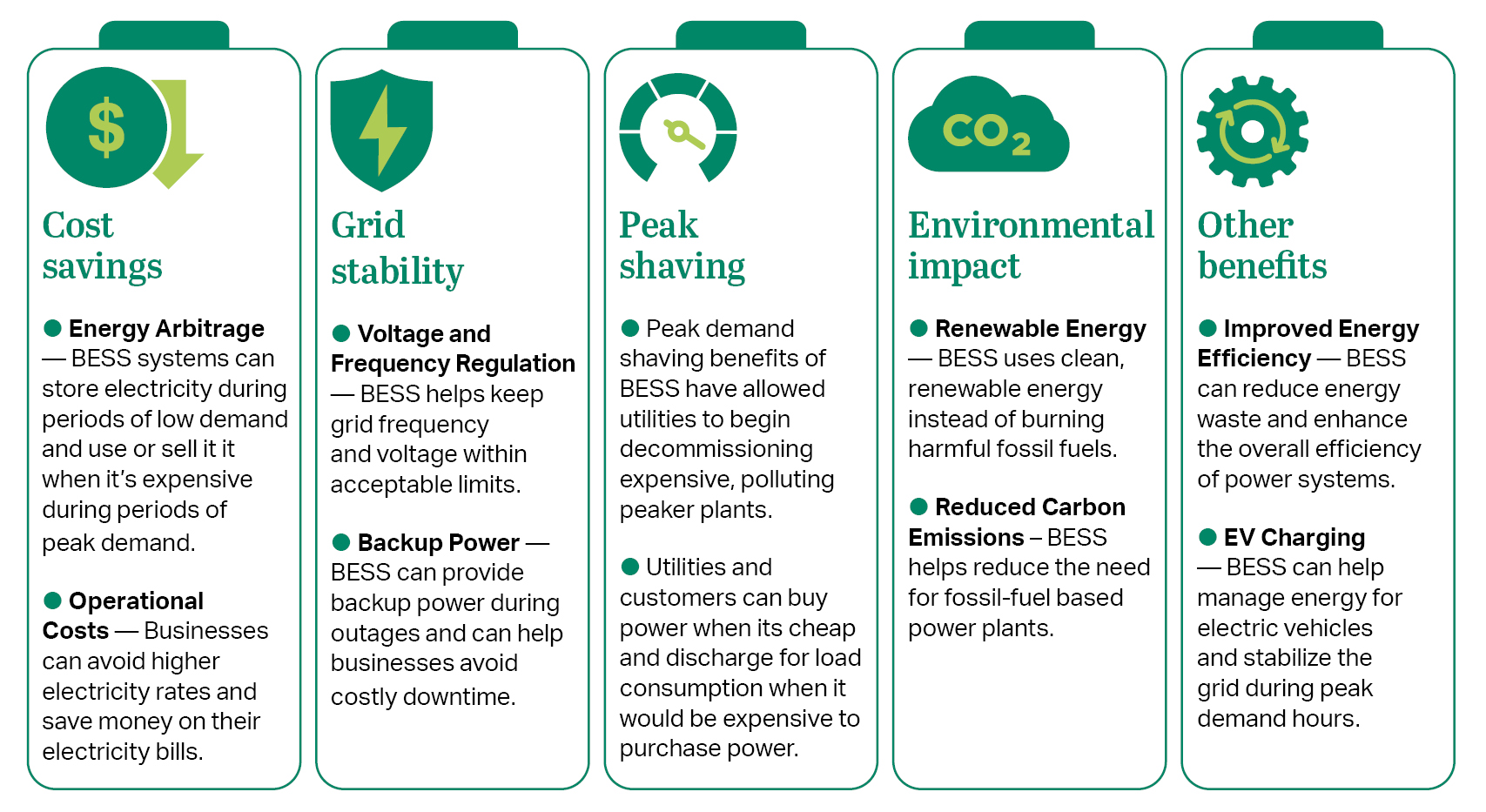
Engaging communities
Effectively engaging the public and addressing community concerns regarding BESS is critical to project delivery.
Local community values must shape messaging efforts, allowing audiences to understand how BESS projects benefit them — whether through resilience for critical local infrastructure or reductions in air pollution.
“By drawing out concerns early in the project planning stages, practitioners can then look for opportunities to refine aspects of the project to address community concerns and targeted messaging to address misconceptions.”
Conversely, by drawing out local concerns early in the project planning stages, practitioners can then look for opportunities to refine aspects of the project. Often, engagement can culminate in investment in local infrastructure or services that can allay community concerns and bolster public support. It’s also important to explain the differences between a newly proposed BESS and older BESS projects that were designed prior to the introduction of newer safety regulations and technologies.
Delivery is as critical as content when crafting messaging. A multipronged, interactive community engagement program maximizes opportunities for education and engagement around BESS.
This may include public meetings, pop-up events, presentations delivered to Community Based Organizations and civic organizations, collaboration with community leaders in vulnerable communities, digital engagement and multilingual approaches. Digital engagement, in particular, provides an opportunity for casting a broad net and providing opportunities for stakeholders to engage at their convenience.
“Delivery is as critical as content when crafting messaging.”
Safety and compliance
Of course, BESS developers must not just win over the public. They must also adhere to stringent regulations and standards.
A whole host of environmental permitting laws, including the Federal National Environmental Protection Act (NEPA) and state regulations like California Environmental Quality Act (CEQA), and New York’s State’s Environmental Quality Review Act (SEQR), all impose extensive requirements on BESS projects, from air pollution and impacts on local flora and fauna to greenhouse gas emissions.
Perhaps the most publicized risk of BESS projects is battery fires. Though battery fires pose real health impacts to local communities during fire events, the technology remains broadly safe — and more so each year with advances in battery chemistries, standards and fire prevention systems.
Between just 2018 and 2023, grid-scale battery failure rates fell by 97 percent worldwide, thanks to increased regulations and safety testing standards such as NFPA 855 and UL9540A implemented during that time. When seeking a BESS supplier, it is recommended to select a manufacturer that meets the newest safety standards set by UL 9540 and UL9540A, which cover the construction, manufacturing, and performance of BESS. The best brands also undergo extensive fire testing.
“Between just 2018 and 2023, grid-scale battery failure rates fell by 97 percent worldwide, thanks to increased regulations and safety testing standards.”
Integrated expertise
While designing a safe, compliant BESS system is imminently feasible, the challenge for many developers is that the requisite expertise often extends far beyond their capabilities.
The key, then, is partnering with permitting experts who understand not just the complexities of BESS technologies but also have integrated delivery capabilities across the whole scope of the environmental sector.
“While designing a safe, compliant BESS system is imminently feasible, the challenge for many developers is that the requisite expertise often extends far beyond their capabilities.”
Battery projects AECOM has delivered have leveraged a broad base of expertise. On projects like the RE Crimson Solar Project in Palm Springs, California, our teams are supporting multiple permits required for numerous state and federal agencies. Within the last four years, we’ve also assisted San Diego Gas & Electric (SDGE) with pre-construction natural resource assessments, engineering support, and geotechnical work for several BESS and microgrid projects in San Diego County.
The benefits of an integrated delivery partner are manifold. Owners can streamline the project development process with more effective cross-functional integration while also enabling handoffs between process steps under a single, comprehensive team.
Standardizing equipment and procurement
There is a high demand for industry components that support grid infrastructure. Continued growth in PV, BESS, electric vehicles, and data centers, has caused multi-year manufacturing lead times and rising costs for transformers, high voltage /medium voltage wire, and breakers critical for BESS projects.
A way to mitigate this challenge is by standardizing equipment purchases of different sizes and categories.
“Standardized purchasing and predictable design allow for confidence within the organization to progress a project and its renewable energy goals.”
Standardization allows greater predictability. Developers can design sites based on known equipment parameters, ensuring material compatibility, and can make predictable long-lead item purchases annually. This relationship between standardized purchasing and predictable design allows for confidence within the organization to progress a project and its renewable energy goals.
Bringing it all together
Technical innovation continues to make battery electric storage ever more viable. Yet, the future of BESS will also depend upon capabilities outside the energy sector.
To sustain BESS growth, developers will need to emphasize public engagement and permitting in development projects, streamline procurement, as well as bring expertise across a whole array of environmental sectors. Unifying these disciplines will not only prove transformative for consumers — it will also make the energy transition a reality.
The post Powering up grid-scale storage appeared first on Without Limits.
]]>The post Integrate program management and unlock the grid appeared first on Without Limits.
]]>Transmission and distribution systems around the world are rapidly undergoing upgrades in response to growing demand. This increase is driven by several factors, including the electrification of transportation and buildings and growth in energy-intensive data center and manufacturing operations. The call for more resilient and secure transmission solutions to safeguard the grid against natural disasters and cyber-attacks has also grown louder. Network operators must re-align infrastructure to address these challenges while connecting new and varied forms of generation to meet the increased demand.
The scale of these upgrades — the number of individual projects, the rate of change and the overall capital expenditure — is unprecedented. In the U.S., National Grid announced a five-year US$35 billion investment in the states of New York and Massachusetts to meet local decarbonization goals. In the United Kingdom (U.K.), the government set ambitious energy goals for 2030, where the Great Grid Upgrade aims to deliver five times more electricity infrastructure over the next six years than what was constructed over the prior 30. And the Australian Government, through its Rewiring the Nation Fund, committed A$19 billion (~US$11.9 billion) for transmission and distribution network infrastructure.
In Europe, transmission giant TenneT forecasts spending €160 billion (US$170 billion) from 2020 to 2030 to triple its network capacity and support carbon neutrality goals. Electricity operators, such as the U.K.’s National Grid Electricity Transmission (NGET), forecast demand doubling by 2050. Despite significant investment, there are several hurdles to clear before grids can meet all the current and future demands placed upon them.
Key challenges to enhancing the grid
Sizeable infrastructure projects often come with equally sizeable challenges. Those associated with the grid must be addressed early on if they are to transform quickly enough to handle the increased demand and requirement for decentralized generation.
The skills gap. A significant hiring need accompanies the growing scale of these modernization projects. The U.K.’s National Grid reported a gap of 400,000 people necessary across the country’s energy sector to achieve net zero by 2050. This represents an uplift of more than 50 percent of the current workforce.
Supply chain issues. As networks worldwide conduct upgrades, the materials and components currently being manufactured are insufficient to meet demand, often resulting in project setbacks. According to the U.S. National Renewable Energy Laboratory (NREL), transformer lead times have quadrupled since before 2022, with utilities experiencing delays of up to two years.
Complex planning processes. Large-scale transmission projects can take several years to progress. Before getting off the ground, local and national planning requirements must be met and meaningful community engagement work undertaken to ensure on-time delivery of project milestones.
Implementing a programmatic approach
Utility companies have traditionally managed new connection programs with in-house resources for everything from investment planning to design and delivery. Conversely, the scale and complexity of today’s grid upgrades has led some to outsource entire projects, relying on contractors for turnkey delivery.
As is often the case, the most effective approach lies somewhere in-between. When it comes to modernizing the grid, an integrated program management model has several benefits:
1. Capacity. Larger projects require more skilled people. Implementing a programmatic partnership can bolster the utility’s workforce for the duration of a project or during peaks in demand throughout a program’s lifespan. Having a partner simultaneously manage resources across multiple projects and activities leads to efficiencies in scheduling, cost and risk management.
New York Power Authority (NYPA). Transitioning from a staff augmentation model to a program management approach is an exercise in organizational change management. Building on more than a decade of collaboration with NYPA, we’re supporting their shift to a value-driven, long-term programmatic approach. As their program partner, we’re providing structure, oversight and coordination in alignment with NYPA’s desired outcomes. Together, we’re enhancing their capacity by streamlining operations, improving knowledge-sharing and increasing access to global expertise.
2. Expertise. Utility companies can take advantage of technical expertise and project management skills they might not otherwise have in-house. This can range from adopting best practices for small individual grid modernization projects to implementing an operating model based on several smaller, high-volume projects across an entire network.
3. A fresh eye. An outside program partner can bring a unique outlook that improves project outcomes. They can offer new perspectives on program management or digital enhancements from prior experience, leading to greater efficiency and performance.
4. De-risking. Working with a partner who has ‘skin in the game’ provides reassurance that they are invested for the entire program lifecycle. Using key performance indicators (KPIs) can help establish that capacity hits promised levels, timelines are met and costs controlled.
5. Unlocking the supply chain. Competition for materials is at an all-time high. The right partner can look across the entire program landscape and flag where lead times might be an issue. They can then engage with suppliers earlier and provide accurate forecasts to minimize holdups.
6. Community liaison. Community outreach is vital for the timely start and completion of any major project. A program partner can engage the community, communicate the benefits of the project and address concerns at an early stage to ensure the entire program or project runs as planned.
San Diego Gas & Electric (SDG&E). SDG&E takes a programmatic approach to community engagement that builds in the resources and processes necessary to be proactive and transparent, fostering open communication and trust. Without this approach, engagement at the project-level can be fragmented, rushed and unclear. By integrating projects into a broader program-level strategy, stakeholders are identified and engaged sooner allowing their concerns to be heard and addressed. This upfront investment in coordination has reduced barriers, saved costs and paved the way for smoother project execution. Ultimately, this approach transformed community engagement into a long-term partnership, creating a replicable model for future community initiatives.
A resilient energy future
A programmatic approach to grid modernization equips utility companies with the expertise and resources needed to modernize their grid infrastructure and meet rising energy demands. Utility companies can increase the scale of their projects, mitigate supply chain constraints, enhance workforce capacity and reduce their own risks. These benefits can lead to accelerated project delivery, optimized costs and authentic community engagement — securing a more resilient and reliable energy future for all.
If you would like to learn more, please contact our grid modernization team.
The post Integrate program management and unlock the grid appeared first on Without Limits.
]]>The post India’s solar century: A perspective on the scaling journey of renewable energy appeared first on Without Limits.
]]>On January 31, 2025, India achieved a significant milestone by exceeding 100 GW of installed solar capacity, becoming the fourth nation to reach this ‘solar century’ after China, the United States and Germany. This remarkable growth—from 2.82 GW in 2014 to 100 GW in 2025, alongside an additional 48 GW of wind energy—further solidifies its position as a global leader in renewable energy.
The decline in solar tariffs during this period has been equally striking. In 2015, prices ranged from ₹4.65 to ₹5.15 per kilowatt-hour (kWh); by 2024, they had dropped to around ₹2.15 to ₹2.40 per kWh. This represents a reduction of 55–60 per cent in nominal terms and an estimated 75–80 per cent when adjusted for inflation.
Having worked closely with multiple stakeholders in the renewable energy sector over the past decade, we have observed four key factors that have underpinned this success, which are outlined below.
1/ Agile entrepreneurship
The solar energy business is not for the faint-hearted. Achieving 100 GW involves the acquisition of around half a million acres of land, over 200 million solar modules, more than 4 million tonnes of steel as well as approximately 25 million man-months of labour—all evidence of the labour-intensive nature of solar projects.
Independent Power Producers (IPPs) face numerous challenges, including land acquisition, supply chain management, timely transmission connectivity, navigating regulatory labyrinths, securing financing, and collecting payments from state distribution utilities.
Leading players in the Indian renewable sector are mainly home-grown companies who have embraced entrepreneurial and agile approaches to address the challenges highlighted above.
Most large international renewable energy companies—despite hiring local management—have struggled to scale effectively in India.
2/ Constructive engagement among stakeholders
The power sector is highly regulated and politically sensitive, involving multiple stakeholders, including IPPs, government agencies, regulatory bodies, investors, vendors, and technology firms. The renewable sector exemplifies effective collaboration among these entities.
The interactions between stakeholders have admittedly not always been smooth. However, on complex issues facing the sector, IPPs and investors have been forthcoming with constructive suggestions and government has been willing to listen and incorporate relevant proposals into policy.
Early policy measures—such as Inter-State Transmission System (ISTS) waivers, the must-run status for renewables and central Power Purchase Agreements (PPAs)—have significantly mitigated credit risks for IPPs.
Moreover, agencies like the Solar Energy Corporation of India (SECI) have played a pivotal role in demand aggregation and the establishment of large-scale solar parks during the early stages of development, when private IPPs were less equipped to assume these risks. This successful partnership serves as a model for scaling collaboration between public and private stakeholders across other infrastructure sectors.
3/ Relentless focus on engineering innovation
Capital expenditure in Indian solar projects is among the lowest worldwide, averaging around $400,000 per megawatt (MW). This benchmark has been achieved despite a reliance on imported solar modules, which account for 50–60 per cent of per-MW costs.
Notably, non-module costs for Indian projects are 60–70 per cent lower than in comparable regions. Innovations include advancements in inverter orientation, structural design, the application of anti-soiling coatings to reduce cleaning frequency and 1.4-1.5X direct current (DC) overloading to maximise inverter utilisation.
Furthermore, IPPs are increasingly adopting advanced analytics, robotics and AI to optimise energy output and enhance project designs. They continue to relentlessly innovate, optimise and squeeze costs out of every element of the plant while maintaining quality and safety standards.
Some commentators have referred to this approach as ‘jugaad’—a term that describes quick, makeshift solutions to overcome constraints. However, this is not just a case of improvisation or short-term fixes. Instead, it reflects a ‘design-to-value’ mindset, where every element of the project is optimised through rigorous engineering and cost efficiency. This focus on continuous improvement is essential in an industry where competition is fierce, and profit margins are tight.
4/ Building investor confidence
India’s renewable energy sector has successfully attracted equity capital from non-government sources, with institutional investors, including pension and sovereign wealth funds, increasing their commitments. This success in attracting global capital is significantly ahead of other infrastructure sectors, particularly in energy.
Key factors contributing to this growing investor confidence include sustained policy stability, strong execution by IPPs and an evolving balance of risks between the government and its private partners.
A review of bidding documents and PPAs from 2015 compared to current iterations reveals a trend toward more bankable and internationally compliant contractual terms. Over the past decade, policies have effectively balanced risk between the government and the private sector, allowing the market to price these risks appropriately and thus offer adequate returns.
Sustaining the momentum
India’s ‘solar century’ is just the first step towards its ambitious target of 500 GW of non-fossil energy by 2030. Innovative models, such as hybrid systems, peak power generation, flexible demand response and energy storage investments, will be key to sustaining this momentum.
This milestone coincides with India Energy Week (11-14 February 2025), where industry leaders are highlighting the need to balance policy objectives related to energy affordability, security, and decarbonisation. India’s rapid renewable energy growth proves that these goals can be pursued together, setting a strong precedent for the future.
Join us at India Energy Week 2025
Suvojoy Sengupta, Chief Executive of AECOM in India, will be moderating a panel at the Strategic Conference on e-mobility during India Energy Week. The session will bring together industry leaders to discuss the future of sustainable transport and the energy transition. We look forward to seeing you there!
Find out more and register here.
The post India’s solar century: A perspective on the scaling journey of renewable energy appeared first on Without Limits.
]]>The post Ten things every developer needs to know about battery energy storage systems appeared first on Without Limits.
]]>Battery Energy Storage Systems (BESS) are at the forefront of the global transition towards a more sustainable and resilient energy future. As grid modernisation gains traction, these systems will play an increasingly important role in meeting the ever-growing demand for clean, reliable power.
However, the development of BESS projects comes with its own formidable set of challenges. These range from technological hurdles to regulatory complexities.
Here, we examine the obstacles that arise in the planning, design and construction of battery energy storage systems and share ten recommendations that developers can action based on our own experience supporting clients to progress major BESS projects of all types in the UK, such as SSE Renewables’ first ever BESS project in Salisbury, Wiltshire.
1/ Stay abreast of technical advancements and compatibility
The rapid evolution of battery technologies poses both opportunities and challenges for BESS developers. Staying abreast of the latest advancements is crucial, as these will have a big influence upon the efficiency, lifespan, and cost-effectiveness of the BESS installation. Developers must carefully select and integrate components to maximise system performance.
2/ Thoroughly analyse site characteristics before selecting an area of land
Before selecting an area of land for potential BESS development a thorough analysis of various important site characteristics must be carried out. These will include, but not be limited to, the type of terrain, proximity to both residential and commercial properties, access – both during construction and operation, environmental conditions, legal status/classification, site size, flood risk and proximity to a suitable grid connection.
3/ Navigate the delicate balance between upfront costs and long-term benefits
While the cost of battery storage technology has been decreasing, the initial capital investment for BESS projects can still be substantial. Securing funding and achieving financial viability remains a significant challenge. Developers need to navigate the delicate balance between upfront costs and long-term benefits, considering factors like battery degradation, through life maintenance, system integration, insurance and end of life costs.
4/ Be aware that regulatory requirements may change during the project lifecycle
Navigating regulatory landscapes can pose a considerable challenge for BESS projects. As BESS is a relatively new technology, regulations and standards are currently diverse and evolving at local, national, and international levels. There is currently not the same body of knowledge available that exists for more established installation types.
Furthermore, regulatory requirements may change during the project lifecycle. Developers need to be aware of this and make project adjustments in real time. Securing necessary permits, addressing environmental concerns, and complying with safety standards demand meticulous planning and engagement with regulatory bodies.
The absence of standardised regulatory frameworks and, in some cases, national or international technical standards for energy storage can introduce uncertainty and delays in project development. Clearly identifying the basis of design and any national or international standards invoked at an early stage in project development is advisable.
5/ Consider timing of grid connection
Integrating BESS into existing power grids presents technical and logistical challenges. Ensuring seamless interconnection with the grid, managing voltage fluctuations, and addressing grid reliability concerns and, in some cases, potential curtailment, are critical aspects of project development. In addition to technical considerations, timing of grid connection must be considered when developing project programmes.
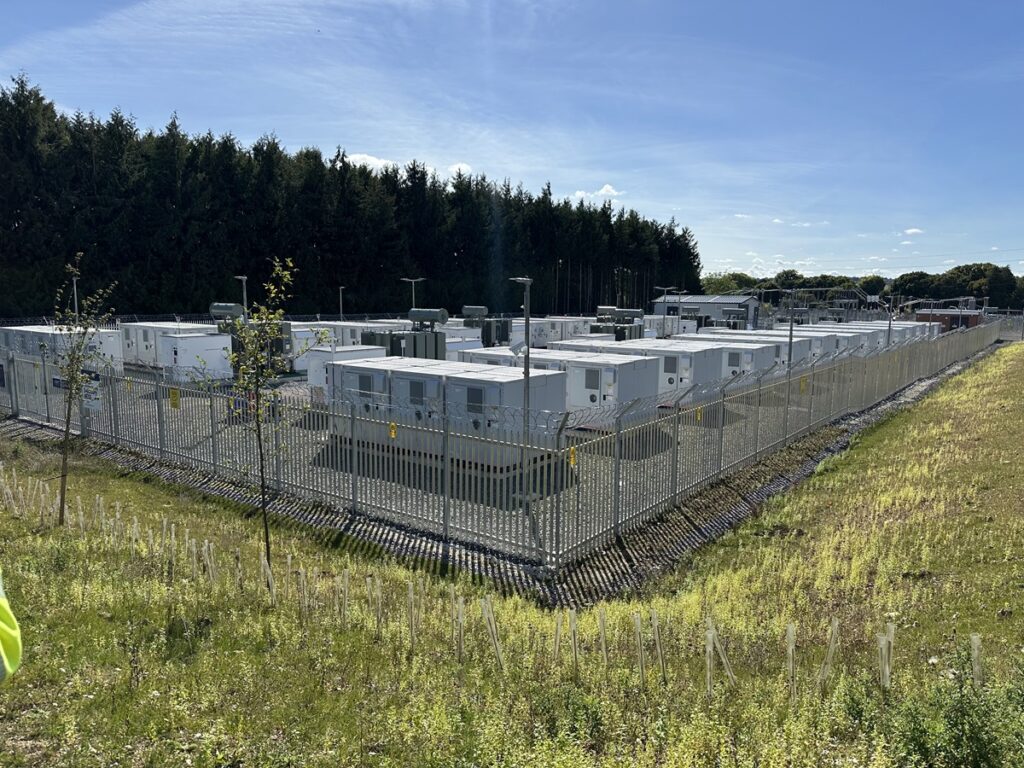
6/ Prioritise sustainable practices in sourcing materials, manufacturing processes, and end-of-life disposal strategies
The environmental impact of manufacturing, operation, installation and disposal of batteries cannot be ignored. Balancing the environmental benefits of BESS with the potential ecological consequences poses a significant challenge. Developers must prioritise sustainable practices in sourcing materials, manufacturing processes, and end-of-life disposal strategies to minimise the overall environmental footprint of BESS projects.
7/ Invest in robust environmental assessments that demonstrate good design
Many BESS installations, which are currently in planning, are in relatively close proximity to residential and/or commercial properties. The local community may well be concerned with issues such as visual impact, fire safety, noise, impact on drainage etc. All these aspects need to be addressed in robust environmental assessments that demonstrate good design and avoidance of significant effects. Residents and businesses must be kept well informed throughout via meaningful community engagement.
8/ Seek supply chain transparency
As laudable as the goal of achieving net zero is, some reports suggest that the supply chain for certain key battery materials e.g., cobalt, lithium, and nickel, has been associated with unacceptable labour practices. These materials are often sourced from countries where ineffective labour regulations and oversight contribute to the exploitation of workers. Transparency at all levels in the supply chain is essential.
9/ Implement robust monitoring and maintenance programmes
Ensuring the long-term reliability and performance of BESS is crucial for project success. Battery degradation over time, unforeseen technical issues, and the need for regular maintenance pose ongoing challenges. Implementing robust monitoring and maintenance programmes and the sharing of operational experience as it is acquired, are essential to address these concerns and maximise the operational life of BESS projects.
10/ View projects through a whole system lens
The above points show that individual BESS projects are a complex undertaking. We know from experience that project development hinges not only on the ability to bring together multidisciplinary teams and skillsets but also the ability to view projects through a whole system lens so that the needs of technology developers, financial institutions, regulatory bodies, and local communities are fully integrated.
Looking at the bigger picture however, these industry-wide challenges must be addressed as the energy landscape continues to evolve. Only then can we unlock the full potential of BESS and deliver maximum benefits to a modernised transmission grid – the backbone of our transition to a clean energy future.
If you’re keen to learn more about the energy transition, click here for more content. You can also find out more about how our team is supporting BESS projects here.
The post Ten things every developer needs to know about battery energy storage systems appeared first on Without Limits.
]]>The post The Natural Capital Manifesto – Establishing a business case for nature appeared first on Without Limits.
]]>Our planet faces interconnected crises compounding into the climate and nature emergency. The degradation of ecosystems and loss of biodiversity can potentially destabilize the global economy.
Despite international agreements and targets, many countries still struggle to meet their goals and arrest declines in biodiversity. This shortfall is largely due to insufficient resources and a lack of effective policy and economic drivers. By aligning economic incentives with environmental sustainability, we can drive meaningful change and protect our natural resources.
To move forward from using carbon as a single environmental benchmark, and foster sustainable economies around nature, we need a strategic entry point that leverages the growing momentum in Environmental, Social, and Governance (ESG) ambitions among corporations.
We believe that the critical issue is recognizing the value of nature and its natural capital. Traditionally, investments in conservation have been viewed as charitable endeavours, lacking explicit returns or gains for companies. However, to bridge the gap between the natural environment and the commercial world, we need a common ground. This is where data monitoring and the quantification of natural capital can play crucial roles, creating synergy by demonstrating the tangible benefits and returns of conservation efforts.
We aim to establish frameworks that recognize and capitalize the value of natural ecosystems, thereby integrating natural capital with traditional financial systems and fostering economies that are aligned with nature. The Natural Capital Manifesto discusses methodologies for measuring conservation impact, showcase case studies, and outline pathways for integrating these insights into mainstream investment practices.
The method: three steps towards nature investments
The Natural Capital Manifesto outlines three steps that merges conservation, digital and AI technologies, and financial incentives to restore ecosystems. These steps involve:
- Creating a high-performance ecosystem – Conserving the last remaining high-performing ecosystems is not enough to overturn the nature and climate emergency. Our focus is therefore to restore ecosystems. This involves applying scientific principles to improve ecosystem performance, ensuring that all restoration actions are grounded in robust research and evidence.
- Natural capital quantification – To quantify the results of restoration and enhancement actions, natural capital accounting will be employed, using five selected performance data points as key performance indicators. Natural capital is defined by a basket of metrics relating to air, water, soil, carbon, and biodiversity.
- Digital monitoring and display – The monitoring process involves establishing a robust and comprehensive data monitoring system using camera traps, audio recordings, and eDNA. This approach ensures thorough and accurate data collection. The data will then be displayed in a natural capital digital twin with a user-friendly interface, making the information accessible and understandable to all stakeholders, including the public.
Moving towards a balanced future
By integrating natural capital investments in their overall strategy, businesses can create a continuous cycle that benefits both natural and financial capital. Investments in green technologies, sustainable practices and conservation efforts can enhance ESG performance, strengthen brand value and improve business sustainability. With today’s nature emergency calling for urgent action, proactive engagement in conservation is essential in business continuity plans and should be an integral part of strategy to help sustain operations and thrive in the future.
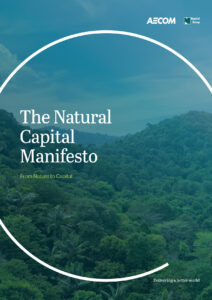
Read the Natural Capital Manifesto here
The post The Natural Capital Manifesto – Establishing a business case for nature appeared first on Without Limits.
]]>The post Navigating offshore wind’s electricity transmission maze appeared first on Without Limits.
]]>The post Navigating offshore wind’s electricity transmission maze appeared first on Without Limits.
]]>The post The time is right to build out Europe’s green ammonia exports appeared first on Without Limits.
]]>The post The time is right to build out Europe’s green ammonia exports appeared first on Without Limits.
]]>The post Powering up the DCO application process on the UK’s strategic transmission infrastructure appeared first on Without Limits.
]]>
National Grid has embarked on The Great Grid Upgrade (GGU) – a massive grid modernisation programme that will entail building five times the amount of electricity infrastructure constructed over the past 30 years in just the next seven.
The GGU is likely to include several developments that will be classed as Nationally Significant Infrastructure Projects (NSIPs). These projects will require the submission of Development Consent Order (DCO) applications to the Secretary of State for Energy Security and Net Zero, which seek permission to construct and operate them.
DCO applications are required for those large-scale energy, transport, water and waste projects throughout England and Wales that meet the criteria set out in the Planning Act 2008.
This regime was introduced to streamline the decision-making process for major infrastructure projects, which is beneficial where projects cross several local authorities but also because the DCO can include compulsory acquisition powers.
Where are DCO applications being used to gain consent for power grid network upgrades?

The UK’s expanding network of subsea electricity superhighways are increasingly seeking consent via the DCO process where they meet the criteria set out in the Planning Act 2008 or where the Secretary of State directs that this is the consenting route that they should follow.
For instance, we are advising on consenting for the Sea Link project, which will link Suffolk and Kent via a subsea high-voltage cable. This has included successfully seeking a ‘Section 35’ direction from the Secretary of State for the project to be treated as if it were a NSIP. The project is now therefore following the DCO consenting process.
DCO applications are also used for terrestrial routes and substation developments – projects which are critical to delivering clean energy generated offshore or via subsea interconnectors to customers across the country.
By way of example, consent for a new high-voltage overhead line from Grimsby to Walpole is being sought via the DCO process, which we are supporting on behalf of National Grid.
How complex is a DCO application?
Regulatory compliance is complex, from a technical and environmental perspective as well as stakeholder engagement.
For example, the A428 Black Cat to Caxton Gibbet improvements scheme in Bedfordshire and Cambridgeshire – a linear scheme brought forward by National Highways which is comparable to the GGU – required a DCO application which included 258 documents with approximately 20,000 pages in total. (The A428 Black Cat project is dwarfed by the GGU, which is likely to require upwards of five separate DCOs, clearly illustrating the scale of the task at hand.)
The process must be as rigorous as possible to navigate all regulatory and stakeholder challenges, address and mitigate potential risks and enable organisations to submit applications that are consistent across all documents and as robust as possible. Broadly speaking, the DCO process is similar across sectors, although there are always project-specific risks and nuances to consider.
The working environment is often highly pressured as the teams manage the complex process, the volume of work as well as the submission deadlines.
Five people-centric ways to power up the DCO process
In the following part of this article, we outline five fundamental ways that the DCO process can be streamlined and optimised while keeping staff wellbeing and stakeholder engagement front and centre.
These recommendations are borne out of our multi-sector DCO experience as well as more than 15 consented successful DCOs on behalf of energy clients within the U.K.
Some of them have been industry firsts and therefore technically challenging, such as the DCO for the first Carbon Capture Usage and Storage (CCUS) scheme linked to a gas-fired power station at Keadby 3, which has already received the green light for development.
For ease, we use our award-winning work on the A428 Black Cat scheme mentioned above as our primary example.
1/Foster collaboration
DCO applications are a team effort, involving many professionals from numerous organisations and disciplines including the client as well as designers, planners, stakeholder engagement specialists, environmental experts and more. This calls for an integrated and collaborative approach at the earliest opportunity, driven by strong leadership.
Exceptionally strong collaboration between key stakeholders and teams was central to success on the A428 Black Cat scheme. Even with multiple stakeholders, including five host authorities, the DCO was accepted early.
Key features of collaborative working included collaboration days and workshops on various topic-specific areas relating to the project timeline such as DCO examination preparation, efficiencies, and lessons learnt. Towards the final stages, co-located staff were able to conduct cross-discipline meetings and reviews to expedite the process.
2/Pay attention to behaviours and wellbeing
A DCO application requires professionals and people who don’t normally meet, yet who are mutually dependent, to work, share, help and support each other – often in highly-pressured situations.
There is great value therefore in proactively investing time and resources in coaching teams to build relationships based on trust and respect, which is what happened on the A428 in partnership with fellow delivery partners and National Highways.
Wellbeing workshops, events and activities were also held across the integrated teams to help them rise to the challenges of the DCO process.
3/Bring contractors to the table early
Early engagement with contractors during the consenting process helps to bring any potential delivery issues to the fore, strengthening the DCOs and accelerating construction when the infrastructure is approved.
This is best practice on major linear infrastructure projects – such as the A428, where contractor Skanska was brought in to review the design from pre-application through to examination stages. This diversity of experience and thought enables a design that can be delivered.
4/Adopt programme management methodologies
As we have discussed before, DCO applications can be sought for projects that meet the criteria set out in the Planning Act 2008. An organisation (such as National Highways) may have several DCOs running concurrently.
However, the GGU differs in that it is a wider programme comprising upwards of five DCOs, which will be managed by just one or two private sector organisations in partnership with National Grid.
We believe that a disciplined, systematic approach using programme management methodologies will be needed to deliver each DCO application in a coordinated way.
As no direct parallels exist in relation to DCOs, industry will need to bring experience from the design and delivery of large-scale linear infrastructure schemes across the world to the GGU, where programme management methods are being applied to obtain benefits for clients otherwise not attainable if project elements were managed separately.
(See the project case study below to find out how programme management methods are being used to scale up the undergrounding of overground power lines in San Diego, California.)
5/Use the latest stakeholder engagement tools and techniques
It is inevitable that the national grid upgrade, with the prospect of pylons striding across the countryside, will be controversial in many communities. As Nick Winser, Electricity Networks Commissioner, points out in his recent report: “Affected individuals and communities are confronted with infrastructure proposals that are difficult to understand and may bring detriment to their lives.”
The consenting process rightly gives ample opportunity for people and organisations to air their views, but also for the government and National Grid to educate and explain to people the aims of the broader programme as well as its local impact.
It is critical, therefore, that public engagement must be meaningful, transparent, collaborative and conducted at the right time. A rich emotionally intelligent approach to public engagement can lead to stronger levels of success when used with the right tools.
Advances in technology are now enabling a far richer engagement experience that combines face-to-face meetings with virtual activities to bring the project to life.
On the A428 Black Cat, we used augmented reality, traffic management animation, video flythroughs, and virtual consultations (a first for National Highways). We also used a Minecraft model and partnered with Mumsnet to reach as wide an audience as possible, which resulted in a ten per cent shift in the proportion of under 45s taking part compared to previous consultations.
A critical collective challenge
Robust DCO submissions will be key to accelerating the deployment of the strategic transmission infrastructure needed to smooth the UK’s transition to a low-carbon economy.
We believe that people, teams and tools are the building blocks to good DCO outcomes. If the UK is to succeed in modernising the grid at the pace required, those building blocks will need to sit on the strongest foundations possible – and that will depend on government, consultants and client working closely together united by a sense of urgency and common purpose.
With thanks to contributors Naomi Kretschmer, Bill Gregory and Phil Wayles.
Scaling up the undergrounding of vital transmission infrastructure in San Diego
Our programmatic approach is being applied within San Diego Gas & Electric’s
(SDG&E  ) service territory through the Strategic Undergrounding Program, which entails undergrounding overhead electric lines to reduce wildfire risk and public safety power shutoffs.
) service territory through the Strategic Undergrounding Program, which entails undergrounding overhead electric lines to reduce wildfire risk and public safety power shutoffs.
Our role is to support the expansion of the overall programme and create a robust programme management offer to support significantly scaling up to meet the increased volume of undergrounding, minimise community disruption, and improve efficiencies.
To prepare for success, the programme delivery team implemented early high-priority and high-impact actions that focused on resource constraints and workload increase. This quick-start approach enabled the team to understand early on areas that could be leveraged to expand success as well as areas of opportunity for enhanced impact.
PlanEngage: community consultation on some of the UK’s leading energy projects
At AECOM, we bring together all our consultation and engagement tools in our powerful PlanEngage platform. Through PlanEngage, members of the public can examine and comment on projects as they look through interactive maps, before-and-after photos, noise and vibration assessments and even 3D models.
It has been used to great effect across many projects, including managing consultation for the ground-breaking Net Zero Teesside carbon capture project.
Our virtual consultation tool is another popular way that we help clients engage with local communities, as demonstrated in the room for the Immingham Green Terminal project.
Want to read more? In her recent blog post, Eloise John, who leads the energy business for AECOM in the UK and Ireland discusses the current imperfect planning system, which is adding extra layers of complexity to the engineering challenge on the Great Grid Upgrade.
The post Powering up the DCO application process on the UK’s strategic transmission infrastructure appeared first on Without Limits.
]]>The post A new alliance is defining the energy transition appeared first on Without Limits.
]]>Just a year ago, experts predicted that the world would exceed the critical 1.5C threshold for global warming— an outcome with catastrophic environmental consequences. Yet, in the past month, that prediction has shifted: the International Energy Agency (IEA) has found staying within 1.5C may in fact still be possible.
So then, what changed? According to the IEA, the answer is a significant growth in green investment and technologies.
An accelerating transition
In 2021, Bloomberg New Energy Foundation estimated that the world spent around $849 billion on the energy transition and green technologies. The following year, that figure grew by roughly 30 percent to a record $1.1 trillion. By the end of 2023, the IEA expects the world to spend $1.8 trillion on clean energy.
While the magnitude of this investment is certainly a success, it can overshadow an even deeper triumph — the alliance that has shaped it.
Even amidst today’s divisions, climate change has generated productive conversations between two parties often seen as at odds: the public and private sector. And that dialogue, thanks to the confluence of business and smart policy, is paying serious dividends.
Through extensive discussion with industry, governments have delivered spending that is not merely record breaking, but, more notably, accelerating the transition to clean energy by supercharging private investment.
High-impact public policy
Over the last several decades, government policy has driven roughly 60 percent of the decline in the cost of renewable energy — with an additional 30 percent coming from the government R&D funding in various nations. Government investment in the energy transition has proven so successful that ensuing private sector investment in renewables has dwarfed it by around two to one.
The global impact is remarkable. The costs of solar and onshore wind energy are now around half that of coal, and by 2025 renewable generation will likely exceed coal entirely. Every day, one billion dollars goes into solar investment alone, with low-emissions power comprising 90 percent of all investment in electricity generation this year.
In the U.S., numerous government policies, including the Infrastructure Investment and Jobs Act and the Inflation Reduction Act, have catalyzed private sector activity in clean energy.
The Department of Energy recently reported that federal actions since 2020 have led to $160 billion worth of investments in clean energy manufacturing nationwide. Driven by strong government incentives, private sector titans like UPS and Amazon have ordered new fleets of thousands of EVs while major automakers plan to roll out nearly 30,000 charging stations in the U.S and Canada.
These outcomes all have one thing in common: they arose from governments engaging with industry to understand how public spending can deliver the most bang for the buck.
Initiatives like the federal government’s Energy Earthshots Initiative illustrate just how central collaboration has become in the fight on climate change. Launched by the Department of Energy, the program has linked policymakers with industry and academia to drive innovation and private sector investment in an array of green technologies — from carbon capture to floating offshore wind.
Connecting the public and private sectors
It’s critical that we see more collaboration. Though we’ve witnessed a significant declining trend in costs of renewable energy, those costs have recently begun to rise. More investment is needed: to stay on the path to net zero by 2050, spending must reach $4.5 trillion annually.
For the private sector to meet this demand, we need government policy to continue to unlock new investment opportunities — especially in developing and emerging markets. Moreover, regulatory stability will be important to ensure this investment is sustained.
Grid infrastructure, for instance, remains critically under-developed and ports struggle to cope with the latest offshore wind opportunities. New approaches to permitting are desperately needed to get these projects off the ground.
Future fuels like hydrogen and sustainable aviation fuel (SAF) demand even more investment and policy intervention. In 2021, around only one percent of hydrogen came from renewables while the 100 million liters of SAF produced in 2019 represent a fraction of the nearly 450 billion liters needed annually by 2050. New policies must incentivize innovation in production technologies to make this scale up possible.
While there’s clearly more challenges to discuss, the energy transition has shown that the divide between private and public sectors is overstated. In fact, the two are more interdependent than ever.
Today, industry is driving action on climate change — and that’s thanks to conversations between policymakers and private sector leaders. As we enter an era of extreme temperatures, two sectors long seen as separate have become perfect partners. For us to reach net zero, that partnership must continue.
Want to know where you stand on the energy transition? Read our latest Future of Infrastructure report for insights from industry leaders for practical, profitable, predictable and people-centric strategies to achieve net zero.
The post A new alliance is defining the energy transition appeared first on Without Limits.
]]>